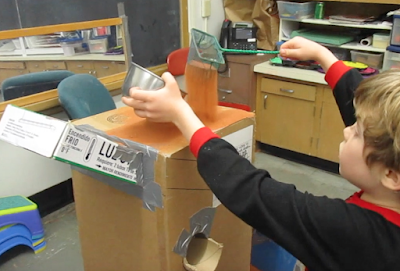Back in March, I wrote a couple of blog posts on the art of pouring:
post 1 and
post 2. Well if there is an art to pouring, there must be an art to filling, too. If so, what would that look like? How do children display the art of filling?
To examine that proposition, I went back to two setups from 2016. For both of the setups, I removed the sensory table from the room. For the
first setup, I set out tubs and pails and shelves with all kinds of containers for pouring and filling.
For the
second setup, which came a week later, I removed some of the tubs but added more containers, scoops, chutes and tubes.
In the video below, a child carried out one of the most common operations for filling: pouring pellets into a a bottle. He placed the bottle on the floor and poured pellets from a scoop. However, the scoop was wider than the mouth of the bottle so most of pellets missed the bottle and fell on the floor.
Pouring pellets 1 from
Thomas Bedard on
Vimeo.
At first glance, that did not look too artful. I still think there was a bit of panache in his operation. As he tipped the scoop to pour the pellets, he used his left hand to hold back the pellets until he had positioned the scoop at just the right angle so he was ready to pour. He could have slowly removed his left hand to better direct the pellets, but instead he quickly removed his hand and the pellets spilled out as if the damn broke holding them back. Did he think that by letting the pellets fall all at once the bottle would fill faster or more would go in the bottle?

Another child filled that same bottle differently. First, he used a smaller measuring cup so he could direct his pour more accurately. Second, he placed the bottle in a pan(on the left) to catch pellets that did not go in the bottle. He also took it one step further by placing the pan in a wash tub(on the right). In the process, his filling operation encompassed multiple containers at the same time.
In the video below, the children filled a white trash bin. That took time and persistence. The child kneeling next to the trash bin used her scoop to gently even out the top layer of pellets. As she did that, another child added even more pellets to the trash can. The child kneeling immediately used her hand and scoop to again even out the top layer.
Evening out to the top from
Thomas Bedard on
Vimeo.
Was leveling out the pellets an integral operation for filling a container? How else would the children have known what constituted full in their operation.?
Somehow filling containers seemed natural. However, the children also found ways to fill objects that were open on both ends. In the video below, two children filled two different tubes, both of which were open on both ends. To do that, they stuck one end of each of their tubes in the tub of pellets which basically created two narrow vertical containers.
Filling two different kinds of tubes from
Thomas Bedard on
Vimeo.
Because the tubes were so different, so were the operations needed to fill each tube. The child on the left used his hands to slowly and methodically direct pellets into a narrow white tube. The children on the right, by contrast, were able to fill the clear plastic tube faster because they could use scoops to fill their tube. Interestingly, once the clear plastic tube was full, one child lifted it out of the tub emptying it immediately. No problem because the child holding the tube jammed it back into the tub of pellets and declared that they would repeat the operation one more time.
One child even found a way to fill a tube horizontally that was open on both ends. To do that, the child used his left hand to push the tube into the tub. Once it was basically buried horizontally in the tub, he dug his right hand into the pellets to find the other end of the tube. Once his hands encased both ends of the tube, he lifted it out of the tub to take stock of his accomplishment.
Filling the tube horizontally from
Thomas Bedard on
Vimeo.
At the end of the video, he turned to me to ask if I wanted to see it come out. Without waiting for an answer, he pulled his left hand off the end of the tube and all the pellets flooded out. Judging from his chuckle, he seemed to take great enjoyment out of filling and emptying the tube.
In the video below, two children went about filling yet another kind of object, one that was open on both ends and on the top. They placed a half PVC pipe on the floor and commenced to fill it.
Filling a PVC half pipe from
Thomas Bedard on
Vimeo.
I think this pushed the boundary of filling. How did the children come to see this as a object to be filled? At what point could the half pipe be considered full?
Taking into the consideration the examples in the post, the children pushed the envelope of what could be filled and how it could be filled. I could say they created a dynamic collage of filling operations. Since art encompasses the possible, the children use the art of filling as one way to make meaning of their world. One meaning for sure has to do with understanding volume using a variety of materials. But like the essence of art, their meaning making through the art of filling had elements that were also imponderable.



















































